Florida Currents

GULF COAST ELECTRIC COOPERATIVE JULY 2024

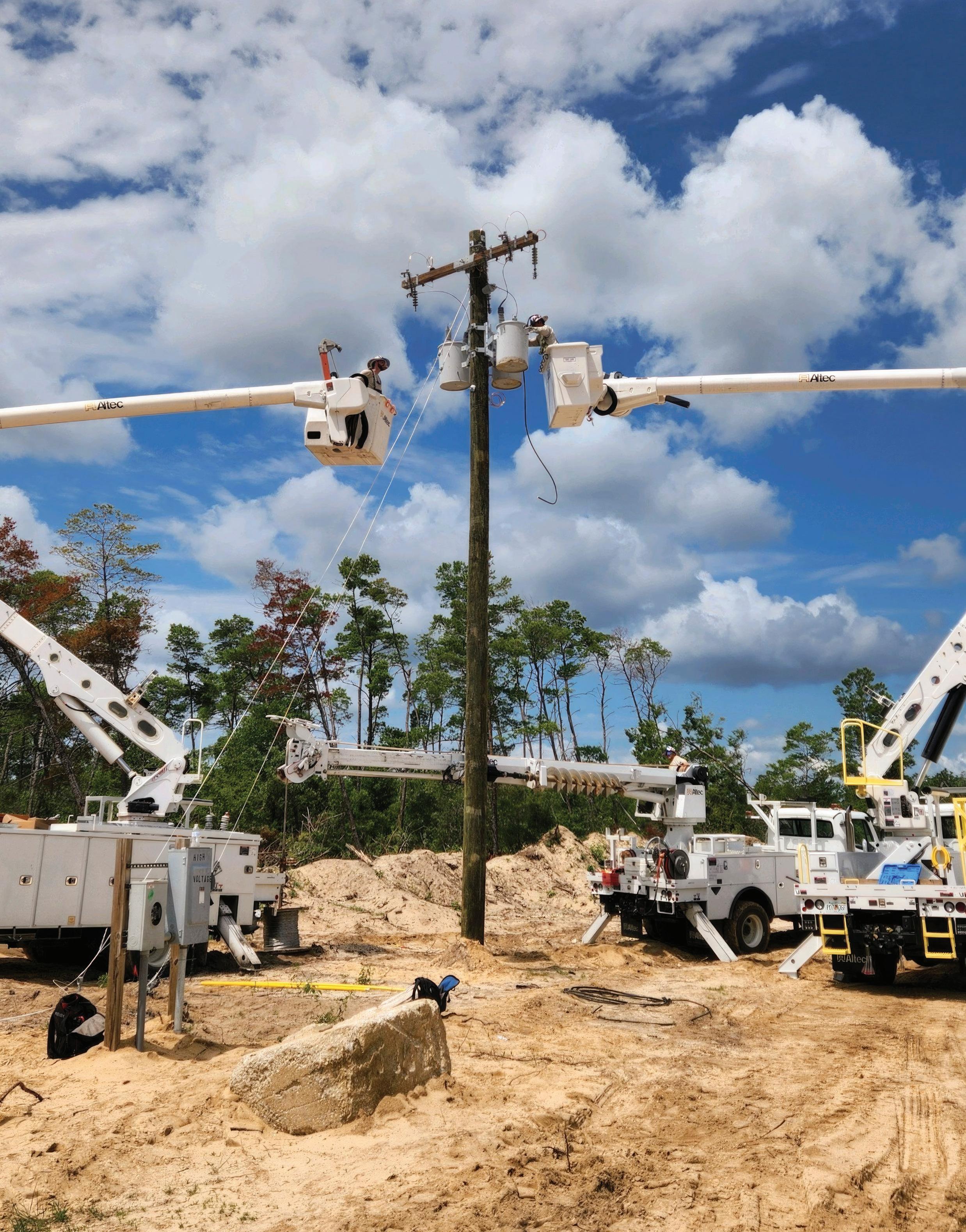





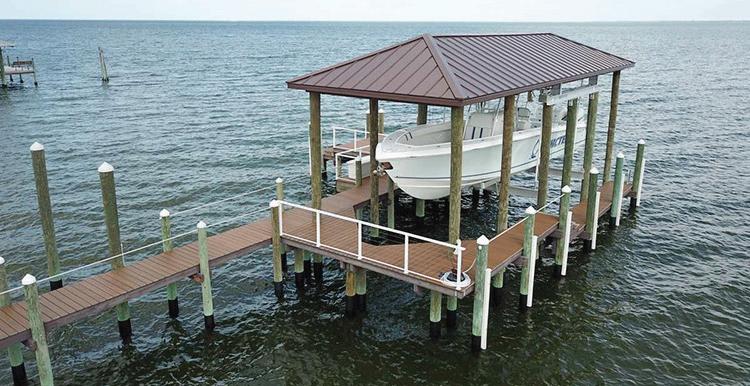

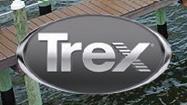






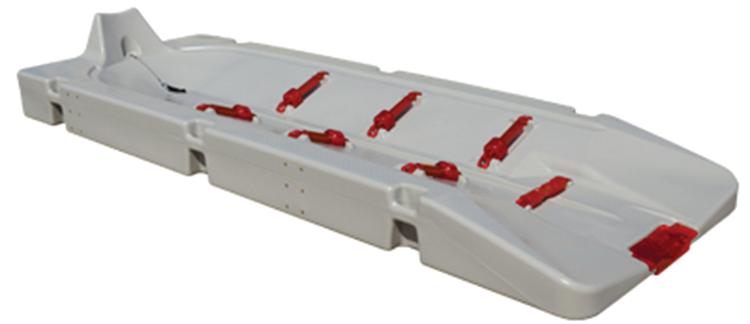


GULF COAST ELECTRIC COOPERATIVE JULY 2024

















July 2024 • Volume 13, No. 9
CEO Michael Shepard
VICE PRESIDENT OF CONTENT Leon Espinoza
EDITORIAL DIRECTOR Mike Teegarden, CCC
DEPUTY EDITORIAL DIRECTOR
Noble Sprayberry
SENIOR EDITOR Jennifer Paton, CCC
FLORIDA CURRENTS EDITORS
Chasity Anderson, CCC; Valeri Pearon
ASSISTANT EDITORS Victoria Hampton, CCC; David Herder, CCC
ASSOCIATE EDITOR
Nina Todea
PUBLICATIONS PRODUCTION
SENIOR MANAGER
Elizabeth Beatty
PUBLICATIONS COORDINATOR
Alyssa McDougle
Members acknowledge that $4.31 a year, plus postage, is the cost to publish 12 issues a year of FLORIDA CURRENTS ISSN 23276304 (USPS 8300). Published by Pioneer Utility Resources Inc., 5625 NE Elam Young Pkwy. Ste. 100, Hillsboro, OR 97124—a not-for-profit Oregon cooperative corporation—the magazine serves the communication needs of consumerowned electric utilities in Florida. Preferred Periodicals postage paid at Hillsboro, OR 97123 and at additional mailing offices.
Postmaster: Send address changes to 5625 NE Elam Young Pkwy., Ste. 100, Hillsboro, OR 97124-6422.
HOW TO CONTACT FLORIDA CURRENTS
Subscription services:
Nonmember subscriptions $15 U.S. a year; $25 foreign a year. Prepayment required. Allow 4-8 weeks for first issue. Identify local edition desired. Have a problem receiving your magazine? Utility members should contact their utility office. Nonmembers call 503-357-2105 or email mailingdept@pioneer.coop.
Back issues:
Back issues and extra copies are $3 each, prepayment required. Supply is limited. Identify edition, month and year. Call first to check availability. Contact Pioneer Utility Resources: P.O. Box 1306, North Plains, OR 97133-1306; 503-357-2105; email: mailingdept@pioneer.coop.
DISPLAY ADVERTISING INQUIRIES
American MainStreet Publications 611 S. Congress Ave. Ste. 504 Austin, TX 78704-1714; 800-626-1181 or 512-441-5200; amp.coop.
© 2024 Pioneer Utility Resources. All rights reserved. Reproduction in whole or in part without written permission is prohibited. Direct reprint requests to editor@floridacurrents.com or for more information, visit www.pioneer.coop.

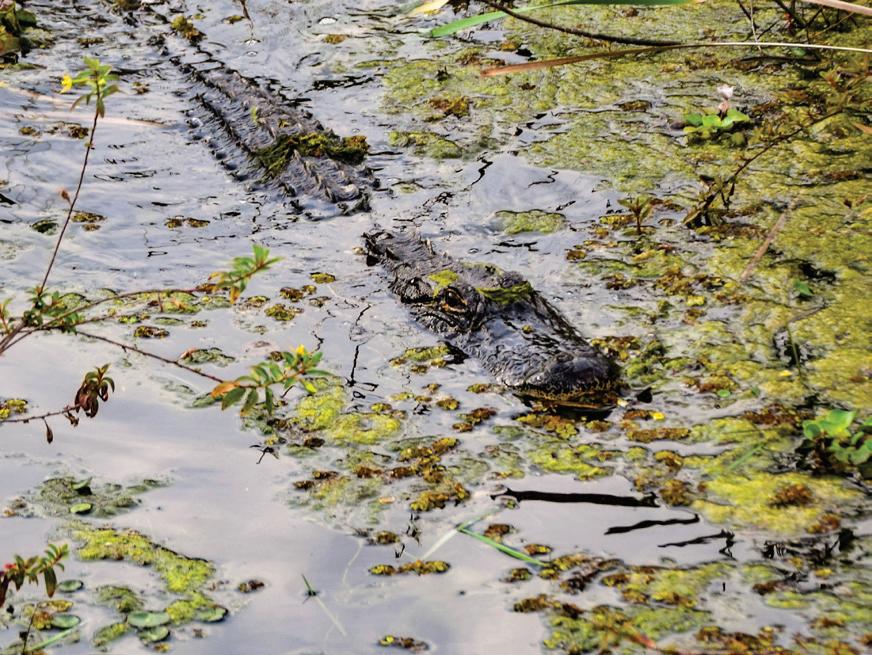
Carl Goodson was elected to represent Gulf Coast Electric Cooperative on Powersouth Energy Cooperative’s Board of Trustees in May.
Carl recently completed a three-year term as vice president of the GCEC Board of Directors. Within his first two years of service on the board, he attained National Rural Electric Cooperative
Association’s Credentialed Cooperative Director Certificate and Board Leadership Certificate. He continues to maintain NRECA Director Gold status as well.
Carl, retired, has two children, David Goodson and Jennifer Mauldin, and seven grandchildren. In addition to spending time with his grandchildren, he enjoys fishing and hunting.

Two Gulf Coast Electric Cooperative employees recently completed all requirements to become line technicians.
Requirements include four years of on-the-job training, all necessary Tennessee Valley Public Power Association education programs and passing GCEC’s in-house tests. Congratulations for a job well done, Dylan and Hunter.


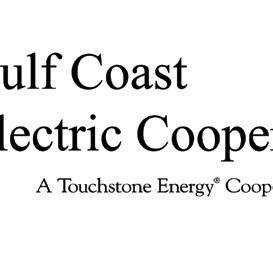




Gulf Coast Electric Cooperative completed its annual member-wide customer satisfaction survey, where over 636 members were asked to participate.
The member responses were sent to the American Customer Satisfaction Index (ACSI®), a company that measures customer satisfaction across multiple
industries throughout the entire United States.
For 2024, GCEC received an ACSI score of 85, on a 100-point scale.*
GCEC’s score is higher when compared to publicly measured investorowned utility scores and municipal utility scores reported in the syndicated 2024
ACSI Energy Utility Study and places GCEC 11 points higher than the average investor-owned utility score of 74, as well as 10 points higher than the municipal utilities score of 75, per the industry ratings.
For more information, please visit www.theacsi.org.























Smart home technologies are transforming how we live, making our homes more comfortable, convenient and energy efficient.
Smart home technologies are devices that communicate with each other to automate everyday tasks and functions around the home, such as heating and cooling, lighting, and security. In addition to convenience, smart technologies enable consumers to manage and monitor their energy consumption through device scheduling and control.
With just a tap on your phone or a voice command to your virtual assistant (like Alexa or Siri), you can conveniently control many aspects of your home environment. If you’re new to the smart tech world, you can try several cost-effective devices as you explore ways to make your home smarter.
One of the best and most inexpensive places to start is with a smart bulb or plug. Smart LED bulbs allow you to control home lighting remotely through a smartphone app or voice commands. You
can set schedules to automatically turn lights off or on, which can help you save energy and boost home security.
Smart plugs are another inexpensive way to give electronics and small appliances the smart home treatment. Smart plugs allow you to set schedules and remotely control power for lamps, small appliances and electronics, minimizing standby energy consumption and maximizing convenience.
For example, you can sync the timing of your bedside lamp, alarm, speakers and coffee maker to turn on at the same time each morning.
If Alexa or Siri is already part of your household, you can build on your existing tech ecosystem by adding a smart hub, such as Amazon Echo or Apple HomePod. Voice assistants synced to smart devices such as bulbs and plugs provide additional options for device management and allow family members to interact with the various devices through voice control rather than individual apps.
Home heating and cooling account for a significant portion of energy use, so a smart thermostat is one of the best smart tech investments you can make.
While traditional programmable thermostats can be set to your schedule and preferences, a smart thermostat takes this one step further by learning and adjusting to your routine and building a schedule around it.
Smart security systems are popular with homeowners looking for advanced
security solutions incorporating cameras, sensors and cloud-based video recordings. As with other smart technologies, smart security systems provide convenient, flexible ways to monitor homes and businesses, giving you peace of mind even when you’re away.
If you’re considering smart tech for your home, start by defining your goals. Is saving energy your top priority, or are you aiming to improve home security?
Smart home technologies provide great
convenience—but remember, they are internet-connected devices. That means you need a stable Wi-Fi connection to ensure devices work properly and strong passwords for your router and individual devices.
Whether you’re looking to automate every aspect of your home or simply want to try a device or two, smart technologies have the power to transform your living space into a home where comfort and convenience reign supreme.

1. Define goals. Determine the areas in your home you want to make smart, such as lighting, security and entertainment systems.
2. Choose compatible devices. A smart hub can make integration easier with a central device to control multiple smart technologies.

3. Check Wi-Fi strength. Smart home technologies require a stable internet connection to function properly, so consider factors such as router placement and signal strength.
4. Prioritize security. Set strong, unique passwords for your Wi-Fi network, set devices to update automatically and limit personal data collection.
Gulf Coast Electric Cooperative is proud to expand an innovative program allowing members to access green energy and its environmental benefits at costs designed to fit their budgets.
Green Power Choice lets members join their local electric cooperative in actively supporting the use of renewable energy—such as solar, hydroelectricity and landfill gas—as a fuel source.
This green power is produced at facilities across the southeast, including an 80-megawatt solar farm and two hydroelectric dams, all in Covington County, Alabama. Additionally, the Springhill Regional Landfill near Campbellton produces electricity by collecting the methane gas created by decomposing landfill waste.
“Gulf Coast Electric Cooperative is proud to expand the Green Power Choice program to include solar in addition to the hydropower and biomass that we’ve produced for many years,” CEO/General Manager John Bartley says. “This project—in collaboration with our wholesale power supplier, PowerSouth Energy Cooperative—grants our members easy access to green energy, which is especially important with resources such as solar.”
The Green Power Choice program is an easy and affordable way for members to access solar through utility-scale facilities without the risks or costs associated with installing their own solar equipment.
Each kilowatt-hour of energy produced at these renewable facilities offsets a kilowatt-hour of generation from nonrenewable sources. By including renewable sources in its energy mix, Gulf Coast Electric Cooperative has diversity and optionality in the fuel sources it can use to bring power to homes and businesses.
Whether members aim to power a home or business, Green Power Choice has various subscription options. For homes, the subscription tiers are $4, $8 or $12 per month, added directly to each month’s electric bill. Business subscriptions start at 1.2 cents per kWh of green energy produced, but Gulf Coast Electric Cooperative also offers custom pricing to suit individual needs. Subscribing to Green Power Choice is a show of market support for the expansion of renewable energy in Alabama and Florida.
For more information, call 850-333-9392 or visit www.gcec.com/our-services/green-power-choice-program.
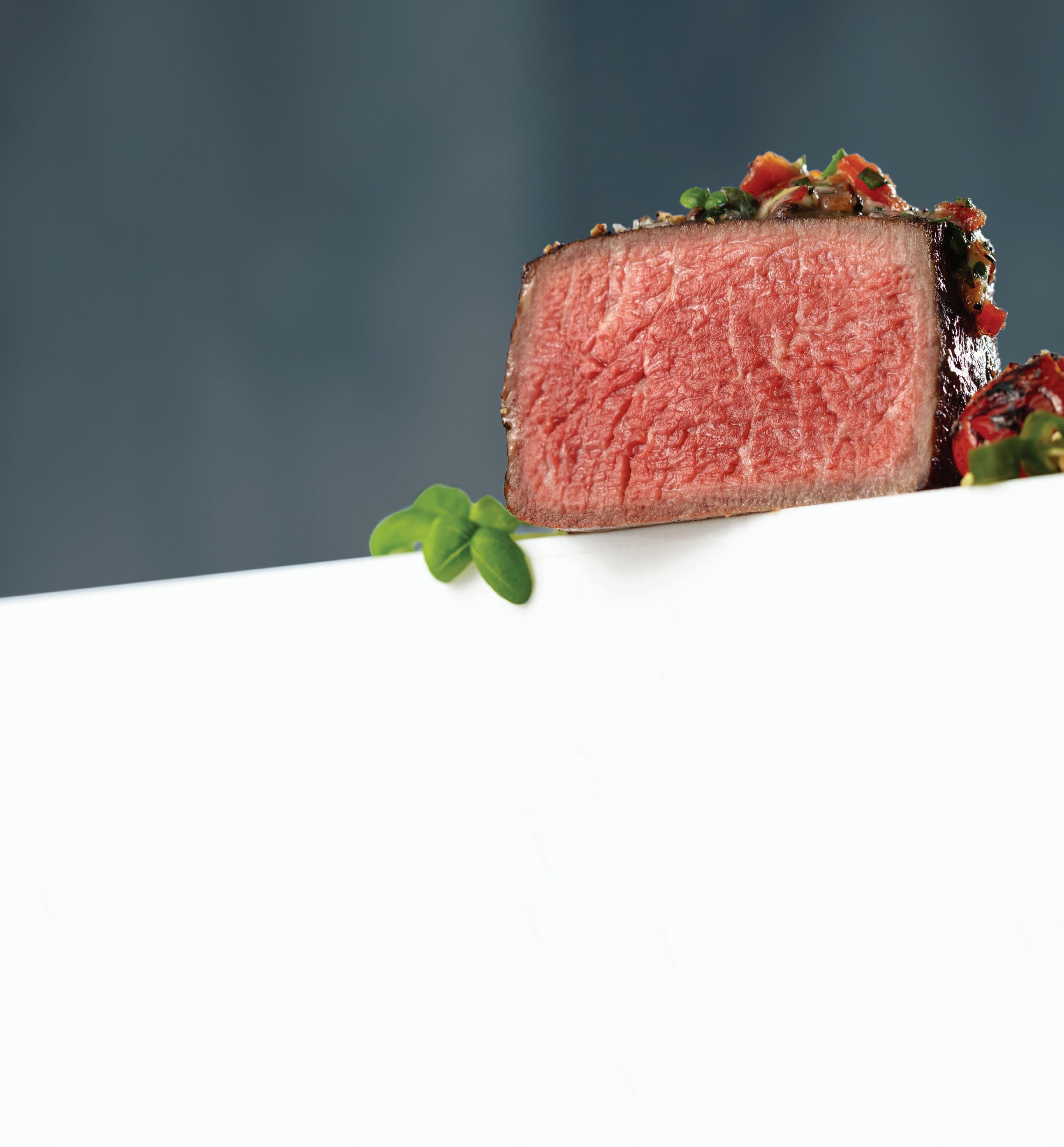
Try the world’s most tender steaks, extra-aged 28+ days to perfection. Discover premium quality beef that’s grain-finished for exquisite flavor.
the juiciest air-chilled chicken, tastiest pork, and so much more.













Despite more than a million alligators calling Florida home, encountering the predators in a city’s business district is a rarity—and residents openly embracing their presence is even more unexpected. Yet in Inverness, the county seat of Citrus County, the waters and marshes of Cooter Pond harbor an abundance of scaly reptiles that coexist with local humans.
Just a few yards from the sheriff’s office and across from the local McDonald’s and Family Dollar Store, this wildlife sanctuary adds charm to the urban landscape. Alligators 4-to-7-feet long freely roam Cooter Pond Park and may be seen from a quarter-mile-long elevated boardwalk built in the early 2000s spanning the southeastern side of the 25-acre pond.
“The boardwalk has been a huge
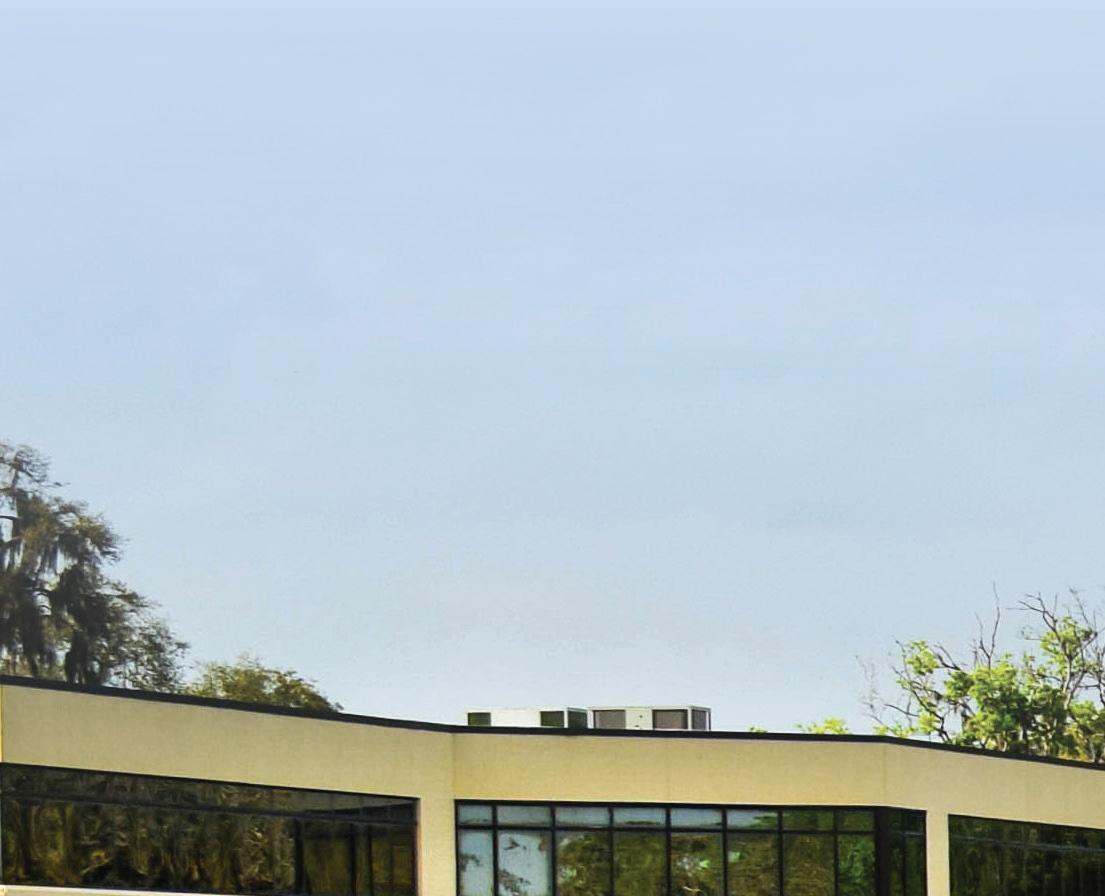
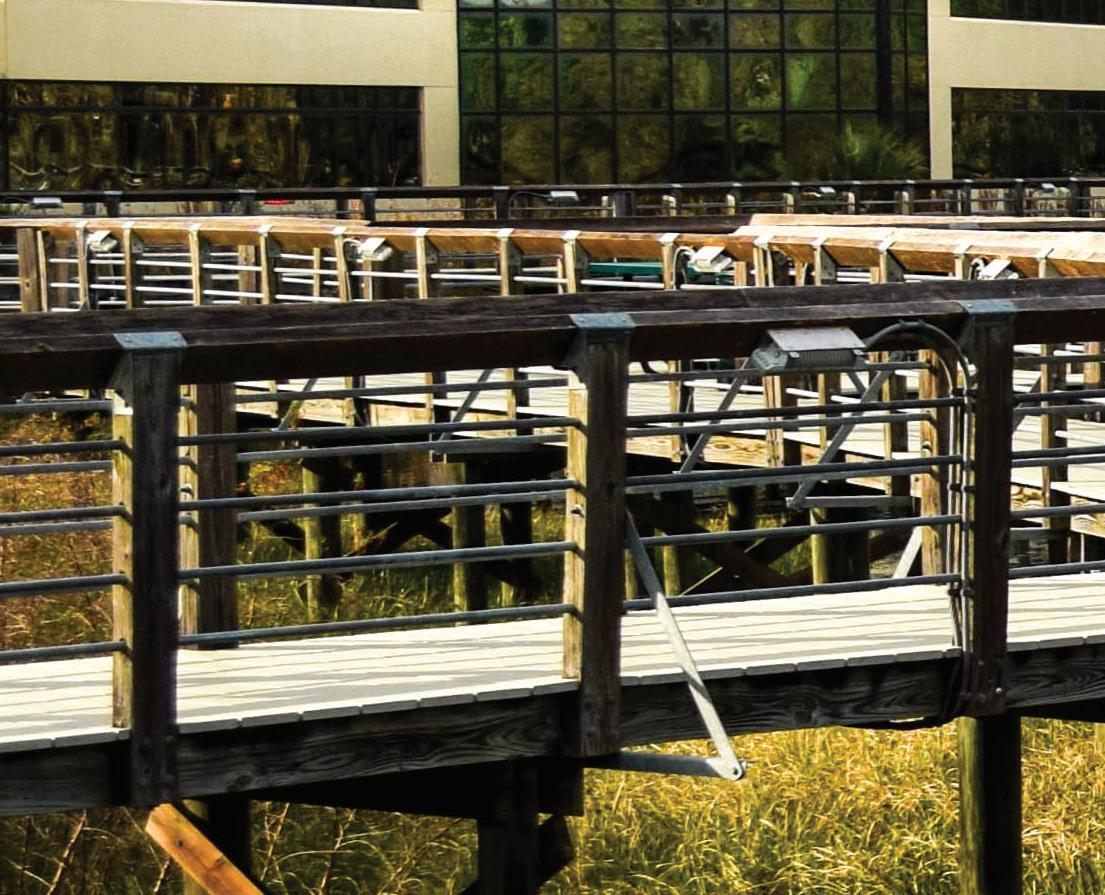

benefit in attracting tourists to Inverness,” says Ken Marotte, a retired cybersecurity specialist and Citrus County Historical Society member. “It allows people to view and interact with nature in the pond in a safe and controlled manner.”
Originally an open cove joining the much larger 422-acre Henderson Lake to the north, Cooter Pond’s eastern bank was filled in during the early 1900s to create the landlocked pond. This enabled the regional Atlantic Coast Line railroad to relocate track along the new embankment, avoiding a sharp curve on the western shore.
“I found a map that showed the ACL line traveling on the new path in the 1920s,” Ken says.
Today, that stretch includes part of the 47-mile Withlacoochee State Trail, one of Florida’s longest paved rail trails.
In addition to the free-range alligators, waterfowl—including egrets and colorful
common moorhens—are regular pond visitors. They feed among thriving aquatic plants like duckweed, cattail and spatterdock. Plant growth can be so rapid in the warm, nutrient-rich water, an ecofriendly aquatic weed harvester sits by an entrance to periodically battle the flora encroachment from species, such as water hyacinth, which threaten to choke the water.
“It’s an invasive plant that reproduces at an impressive pace,” Ken says. “Not only does it block sunlight at the surface level, but as the old plants die, they form a thick level of sediment on the bottom.”

Contamination of Cooter Pond water proved challenging over the years. At one time, even human waste flowed into the water from the town septic system. Ken says that even after the city upgraded its sanitary facilities, overflow sewage was still pumped into the pond.
“The opening of a new shopping center


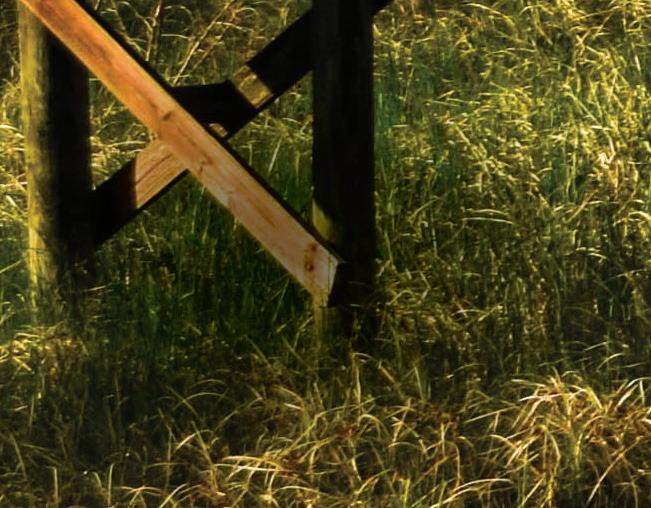









in the 1970s, where the current WinnDixie is located, created a new challenge since their runoff flowed into the pond as well,” he says. “The situation was rectified when Inverness stopped using the pond for that purpose.”
Decaying plants and untreated stormwater runoff clouded the pond with organic sludge. In the 1980s, plans to beautify the downtown business district included Cooter Pond and the surrounding area. Stormwater was routed away from the pond, the boardwalk was constructed and a striking decorative fountain was added to provide water aeration. Since 2002, the floating mechanical harvester—which the Tampa Bay Times called “a giant underwater lawnmower”—has helped keep plant growth in check.

“The boat moves along the surface and


cuts or funnels plants into the holding area,” Ken says. “The plants are then removed from the boat and destroyed. The pond has had its share of ups and downs over the years and gone from the polluted Rodney Dangerfield of local water bodies—that is, got no respect—to a gem offering inspiring views of nature.”
Now a source of local pride, Cooter Pond Park is a center of Inverness activities. The Citrus County Historical Society even offers children’s programs.
“One of those sessions is called the Turtle Walk, where the children are led across the boardwalk as part of a guided tour and encouraged to find as many resources on their checklist as they can,” Ken says.
While unaware of alligator attacks in the pond area, he still advises, “I would not be inclined to walk close to the banks of the pond.”


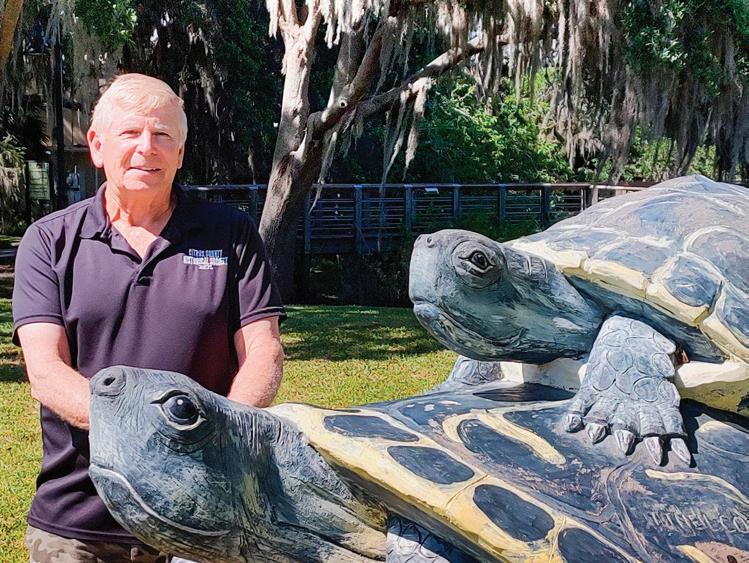
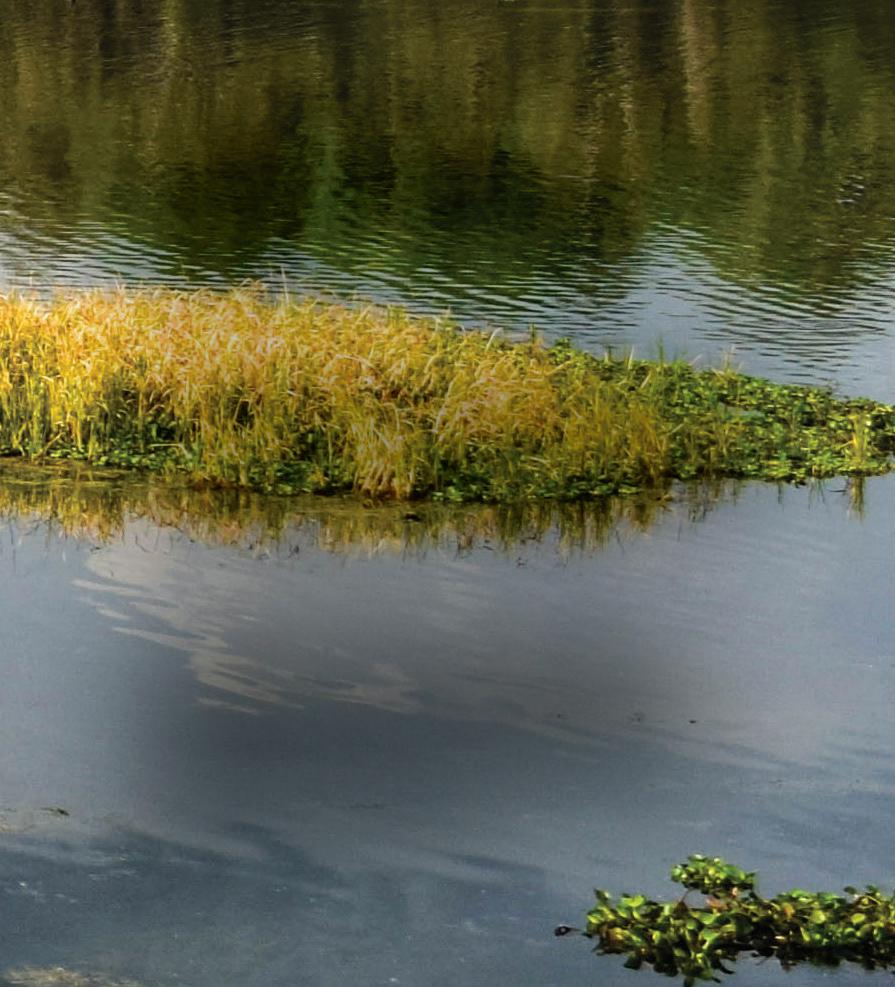

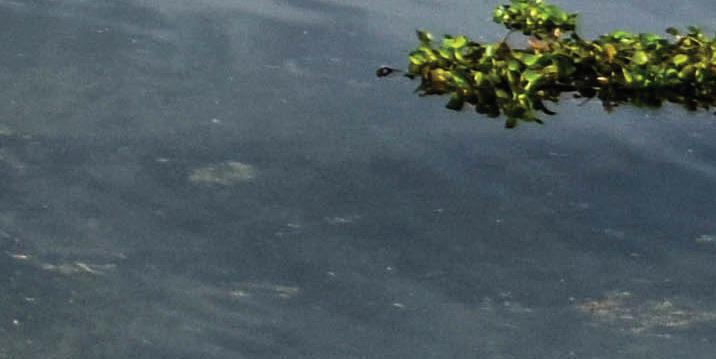
Is Cooter Pond named after a turtle?
True. Seen gracefully swimming through the pond water or basking in the sun on its banks, the docile Florida Cooter grows up to 12 inches and sports a yellow or orange shell pattern on a dark background.
Is Inverness named after a Scottish town?
That is probably true, but who first suggested the name has been open to speculation for many years. Ken Marotte of the Citrus County Historical Society says the name dates from the late 1800s and “a preponderance of evidence points to the Florida Orange Canal & Transit Company—specifically Director/Secretary Alexander B. Campbell—as the most likely source.” His parents were Scottish, with maternal ancestors coming from Inverness, Scotland, where Campbell was known to visit.
Is there a 1930s train wreck at the bottom of Cooter Pond?
Probably false. For some five decades, stories have circulated suggesting several railroad cars rested on the bottom of Cooter Pond from an earlier derailment. None have been found to date.
“I view this story as another fascinating legend in Citrus County history,” Ken says. “The turtles know the real story— and they aren’t talking.”



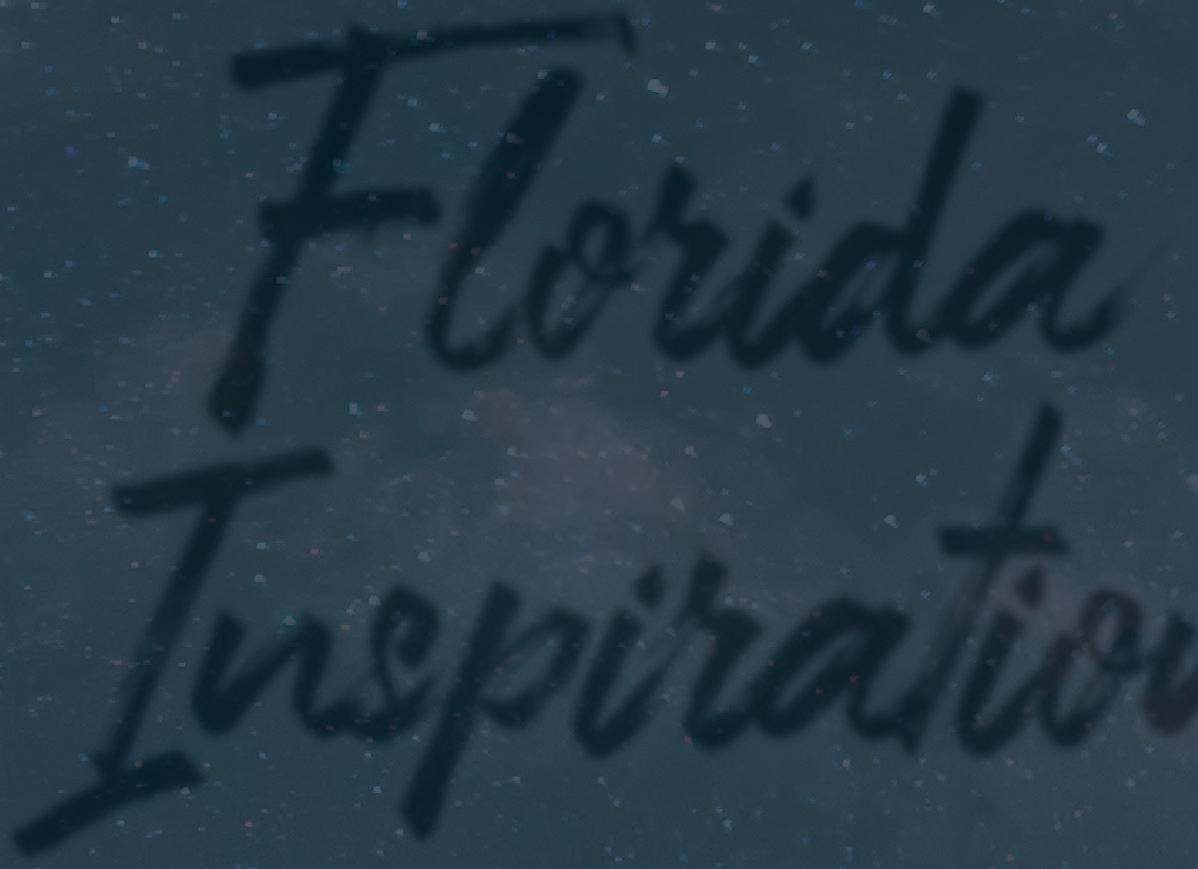
By Theresa Sterling


Florida’s wild beauty has always inspired, captivated and attracted artists. Orange sherbet sunsets, dark forests dappled with pops of bright blooms and coasts where liquid emerald meets sugar-white sand have long been the focus of the artistic eye.
Those who have seen works by the Florida Highwaymen landscape artists or heard English composer Frederick Delius’ 1887 “Florida Suite” understand. Delius composed his orchestral work three years after his unforgettable time in Florida managing his family’s orange groves by the St. John’s River. Though the composer’s time in the Sunshine State was brief, the magic of the landscape and culture lingered into his old age.
If there is a common theme among creatives who attempt to capture the essence of rural Florida, it is a combination of awe over the state's unique beauty and concern for preservation of natural spaces and history.
Following a historic painting tradition, High Springs artist Karen LeMonnier is a plein-air artist, painting on location and outdoors. She is usually the first to put brush to canvas during outdoor “paint out” events or when gathering with colleagues, rushing to capture the changing morning light.
“I set up and jump in—I don’t do a lot of prelims,” she says, referring to sketches and small studies some artists do before deciding the final composition of a scene. “I do take photos to help me finish a piece in the studio, but I do 90% of a painting plein-air.”

French for “open air,” plein-air painting dates to early-1800s Britain. It was the hallmark of impressionism by around 1860 and boomed in popularity a decade later when oil paint became available premixed in tubes. Plein-air painting has always been physically demanding, with 19th-century artists lugging boxes of pigments, canvases, wooden easels and other supplies with human or animal assistance in the days before automobiles.
“It still is demanding now,” Karen says. “Some painters don’t like working outside because there are too many variables, and it is physically exhausting. But it’s what I love to do.”
Karen focuses on Florida’s natural beauty and historic architecture. Her favorite location is Blue Springs at Ruth B. Kirby Gilchrist Blue Springs State Park—roughly one-third of her paintings feature the spot. Her paintings’ Prussian-blue depths,







horizon lines of cypress knees, water oaks and golden grass marshes convey an intimate understanding of the natural surroundings only possible through close observation.
The springs are near the historic High Springs home Karen shares with her husband, Larry. They met at the Ringling School of Art in Sarasota in 1968 and celebrate 53 years of marriage this year. They chose High Springs for their home because of its rural backdrop and the easy drive to places that inspire Karen’s painting, including Cedar Key, St.





Augustine, Paynes Prairie and Evinston.
She paints four or five days a week, and studio time is spent finishing off work she started outdoors. An award-winning painter, her work is shown in galleries in High Springs and Gainesville and at culminating plein-air receptions where paintings are often hung while still wet.
“I Iike to work instinctively, and I love to paint outdoors,” Karen says. “We are in the heart of gold here in Florida, with our springs and rivers. I can’t go to Blue Springs without getting inspired. I can’t not paint here. It’s like magic.”

The images captured by photographer Jimmy Daniels, mostly around North Florida, bring history to the forefront in captivating ways—an abandoned plantation home, a tree canopy above clay road banks, a half-sunken oyster boat battered by the Gulf Coast sun.
“There are no more old oyster boats around," Jimmy says. "At one time, Apalachicola Bay provided almost all of America’s oysters. Rural America is being lost, culture is changing in front of our eyes, and people aren’t seeing it. It’s important to remember what we had.”
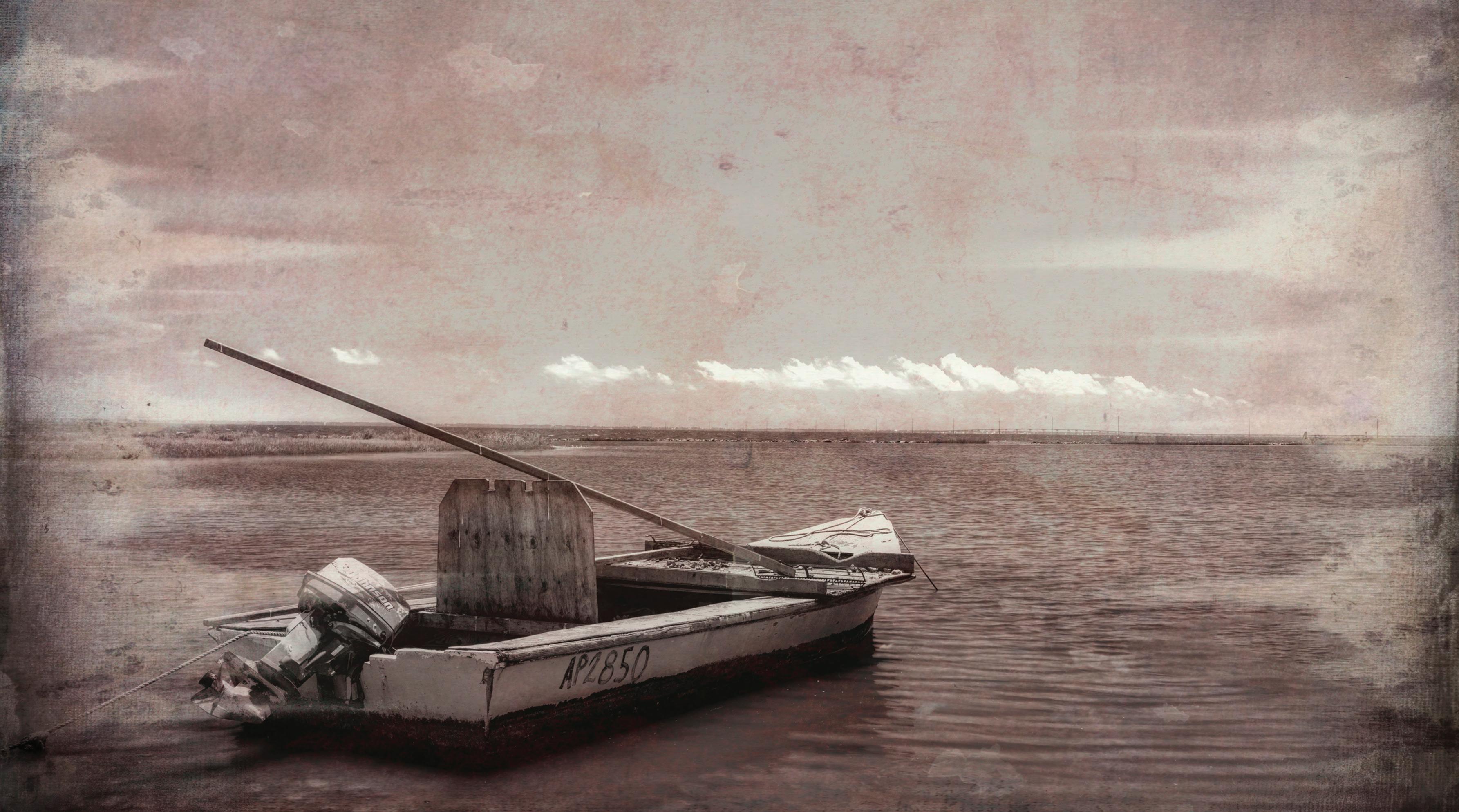
Rural Florida has always drawn Jimmy. The Panhandle’s coastal areas juxtapose unique features—old plantations, rustic fishing villages and working farms. There is so much in this place where Jimmy grew up that he wants to share.
“Some places in America just don’t have what we have in North Florida,” he says. “I want to see wilderness and nature, and I want others to see it, too.”
Jimmy has taught workshops, shown his work in galleries and won several awards, including from arts organizations such as LeMoyne Arts in Tallahassee and the Florida Council on Culture & Arts. The accolades, while appreciated, do not outshine his mission of wanting viewers to feel a scene.
“I spend 20 minutes tops on postediting per photo,” Jimmy says. “I don’t want my images to look overcooked, and I stay true to single exposures except in rare situations, such as panoramic photos or an occasional overlay of two images. I want a true picture. That’s the best outcome.”

Rural America is being lost, culture is changing in front of our eyes, and people aren’t seeing it. It’s important to remember what we had.”
—Jimmy Daniels, photographer


His focus has not changed, even though his work as a travel nurse has taken him away from Florida. He rides back roads for inspiration wherever he’s working. The area looks very different now, but when he comes home, he always brings his camera and heads straight out to St. George Island or Apalachicola.
Linda Blondheim has many titles: Certified upland and wetlands naturalist. Landowner. Arts educator. Conservationist. Nonprofit volunteer. Nature lover. Artist.
The Alachua County native lives on family land, tucked into the northern part of the county—a stark contrast to the city center, home to the University of Florida. Her studio backs up to woods behind her home, oil paintings stretching from floor to ceiling.
“I have been around wild and natural old Florida for a long time—forever,” Linda says. “I wouldn’t trade my rural existence for anything.”
Linda paints natural subjects, the Florida light captured in palms, prairies and citrus, which occupy that indelible place in Florida’s memory.
“As a naturalist and a painter, wildlife and land stewardship are very important to me,” she says. “Stewardship is all we have. We don’t own the land.”

Linda says she is a better studio than plein-air painter, and she paints every morning and late afternoon. She drives along back roads and takes photos to inform her work in the studio.

“I am always looking, looking, looking," she says. "Even when I have a private artist residency, mostly I just look,” she says.
Linda’s talent emerged early. At age 8, she took drawing classes with a group of friends. At 13, her parents bought her an adult easel and a set of oil paints. She raided her mother’s kitchen for still-life subjects—eggs, peppers, fruit—and stole upstairs to her attic bedroom-studio to paint. She earned her Bachelor of Fine Arts at the University of Tampa and her Master of Fine Arts from the University of South Florida.
Linda’s art is part of her work trying to preserve Florida’s natural resources. She volunteers with the Fair Oaks Foundation, a nonprofit committed to “encouraging the Florida culture of arts, music and agriculture.” She helps organize fundraising events, such as the annual Summer Solstice Soirée, highlighting a few select Florida artists each June. As a Certified Master Naturalist, Linda guides individuals and groups interested in making good decisions for conservation.
“Every day, I wake up and think, ‘Oh my gosh. How lucky I am to have this in my life?’” Linda says. “Every piece I have painted is always about a place that is important to me or to the person I am painting it for.”
To find out more about Karen’s art, visit www.karenlemonnier.com. More of Jimmy’s photos can be found at backroadsphotographyllc.com. Linda’s art can be found at www.lindablondheim.com.







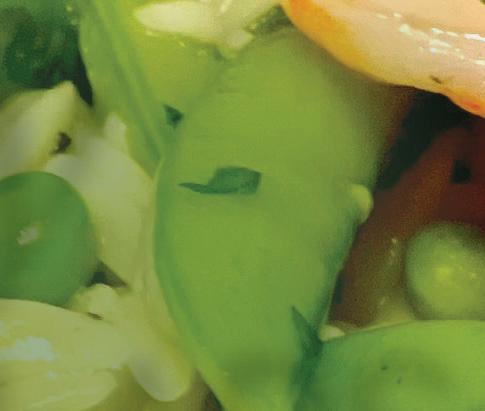




Orzo Salad With Shrimp and Lemon Dressing
¼ cup extra-virgin olive oil
1 teaspoon lemon zest
3 tablespoons fresh lemon juice
1½ teaspoons kosher salt
½ teaspoon black pepper
1 cup uncooked orzo
8 ounces fresh asparagus, trimmed and diagonally sliced into 1-inch pieces
4 ounces fresh sugar snap peas, trimmed
1 cup fresh or frozen English peas, thawed if frozen
12 ounces medium raw shrimp, peeled and deveined
¼ cup coarsely chopped fresh chives
¼ cup coarsely chopped fresh flat-leaf parsley
Whisk together oil, zest, juice, salt and pepper in a small bowl. Set aside. Prepare orzo according to package directions, omitting salt and fat. Drain. Transfer orzo to a bowl. Cool to room temperature, about 10 minutes. While orzo cooks, bring a large saucepan of water to boil over high heat. Add asparagus and sugar snap peas to boiling water. Cook until bright green and tender-crisp, about 2 minutes. Add English peas. Stir until softened, about 30 seconds. Using a slotted spoon, transfer vegetables to an ice bath, reserving boiling water in saucepan. Add shrimp to boiling water. Cook until opaque, about 3 minutes. Drain. Transfer shrimp to ice bath with vegetables. Let stand until chilled, about 3 minutes. Drain. Toss together shrimp-vegetable mixture with orzo, and drizzle with dressing. Add chives and parsley. Toss to combine. Serve at room temperature or chilled.


Salad
¼ cup slivered almonds
6 to 8 cups mixed butter lettuce
3 small ripe peaches, sliced
Dressing
1½ tablespoons white balsamic vinegar
1 tablespoon Dijon mustard
1 tablespoon maple syrup
½ red onion, thinly sliced
½ cup canned corn, drained
4 ounces soft goat cheese, crumbled
¼ cup olive oil
¼ teaspoon kosher salt
Fresh ground black pepper
Place the almonds in a dry skillet over medium heat. Heat, shaking the pan and stirring often with a wooden spoon, until the nuts are fragrant and golden brown, about 4 to 5 minutes. Remove immediately from the heat and transfer to a plate.
To make the dressing: In a small bowl, whisk together the balsamic vinegar, mustard, maple syrup, olive oil, kosher salt and several grinds of fresh ground black pepper until thick and emulsified.
To serve, top the greens with almonds, peaches, red onion, corn and goat cheese. Drizzle with dressing. Serve immediately.
Dressing
1 ripe avocado, pitted and peeled
¼ cup red wine vinegar
2 tablespoons fresh lime juice
2 tablespoons chopped fresh cilantro
Salad
2 heads romaine lettuce, chopped
15-ounce can black beans, drained and rinsed
1½ cups grape tomatoes, cut in half
1 orange bell pepper, seeded and chopped
1 cup frozen corn, thawed
½ jalapeno, seeded and coarsely chopped
1 clove garlic, coarsely chopped
½ teaspoon kosher salt
½ teaspoon ground black pepper
½ cup olive oil
1 cup shredded pepper jack cheese
4 green onions, sliced
½ cup chopped fresh cilantro
1 ripe avocado, peeled, pitted and cubed
½ cup crushed tortilla chips or strips
To make the dressing, add the avocado, red wine vinegar, lime juice, cilantro, jalapeno, garlic, salt and pepper to a food processor. Blend or pulse until almost smooth. There should still be bits of cilantro. Add the oil. Blend until incorporated.
To make the salad, add the lettuce, black beans, tomatoes, bell pepper, corn, cheese, green onions, cilantro, avocado and tortilla chips to a large bowl. Drizzle with the dressing, and toss to combine. Serve immediately.
24 ounces baby red potatoes, scrubbed and halved
10 cups water
1 tablespoon plus ½ teaspoon kosher salt, divided
4 thick-cut bacon slices, chopped
½ cup sour cream
½ cup mayonnaise
1½ tablespoons chopped fresh chives
1 tablespoon chopped fresh flat-leaf parsley
1½ teaspoons fresh dill
1 teaspoon fresh lemon juice
¼ teaspoon grated garlic
¼ teaspoon black pepper
4 ounces mild cheddar cheese, shredded
Place potatoes, water and 1 tablespoon salt in a large pot. Cover pot and bring to a boil over high heat. Uncover pot and reduce heat to medium-high to maintain a moderate boil. Cook, stirring occasionally, until potatoes are fork-tender, about 12 minutes. Drain potatoes. Cool for 20 minutes.
While potatoes boil, cook bacon in a nonstick skillet over medium, stirring often until crisp, about 9 minutes. Remove from heat. Transfer bacon to a paper towel-lined plate. Set aside until ready to use.
In a medium bowl, whisk together sour cream, mayonnaise, chives, parsley, dill, lemon juice, garlic, black pepper and ½ teaspoon salt.
Add sour cream mixture, bacon and cheese to cooled potatoes in bowl. Toss to combine. Serve immediately, or cover and store in the refrigerator for up to 12 hours.
1 cucumber, unpeeled, seeded and sliced ¼-inch thick
1 red bell pepper, large-diced
1 yellow bell pepper, large-diced
1 green bell pepper, large-diced
Vinaigrette
2 cloves garlic, minced
1 teaspoon dried oregano
½ teaspoon Dijon mustard
¼ cup red wine vinegar
1 pint cherry or grape tomatoes, halved
½ red onion, sliced in half-rounds
½ pound feta cheese, ½-inch diced
½ cup Kalamata olives, pitted
1 teaspoon kosher salt
½ teaspoon freshly ground black pepper
½ cup olive oil
Place the cucumber, peppers, tomatoes and red onion in a large bowl.
To make the vinaigrette, whisk together the garlic, oregano, mustard, vinegar, salt and pepper in a small bowl. Still whisking, slowly add the olive oil to make an emulsion. Pour the vinaigrette over the vegetables. Add the feta and olives. Toss lightly. Set aside for 30 minutes to allow the flavors to blend. Serve at room temperature.
By Dave LaBelle
As a school-age child, I could hardly wait for the last day of school and the beginning of summer vacation, where freedom, sunshine, time with my dogs, fishing in the creeks, baseball games, watermelons, swimming pools and working with my grandfather on his fishing boat awaited.
As an adult, those carefree summer memories still bring me joy and serve me faithfully in storytelling, whether with words or photographs. In fact, beginning writers, unsure what to write about, are often encouraged to start with their childhood, a treasure chest rich with stories.
While childhood memories are a good source of inspiration for activities, making photographs that capture the essence of summer requires thought.
“Don’t just show me what something looks like,”

Renowned author, photographer and lecturer
Dave LaBelle has captured special moments for more than half a century. For more of his writings, visit davidlabelle.com and bridgesandangels.wordpress.com.

I often admonished my photojournalism students.
“Show me what it feels like.”
That was a common theme in all of my classes, and it remains sound advice for anybody using photography to communicate. If you want to reach people with your photographs, aim high. Those images connect us and make us smile or remember.
Consider what is in the frame when you press the shutter. Being patient and watching for storytelling moments is critical. The act of fishing might not be nearly
as storytelling as the reaction of the angler once the fish is caught.
Conversely, an overall scene of a fisherman in a beautiful stream might best evoke the serenity of the moment. Sometimes the liberal use of negative space—that which is not occupied by people or objects—helps humble us and wrap us in wonder.
Finally, consider the angle from which you photograph. A child’s perspective is different than an adult’s, and subtly helps take us back to those long, carefree summer days. n
See if you can make a photograph that captures the joy or the essence of summer. Reach into your memory bank and consider what you loved most about summers. Chances are the places and activities that brought you joy in the past—lakes, campgrounds, fishing villages or swimming pools—will lead you to where you find the best pictures today.
Email your best image (just one, please) with caption information, including an explanation of how it affects you, to GPH@pur.coop. We may share submissions on our website and social media channels.




























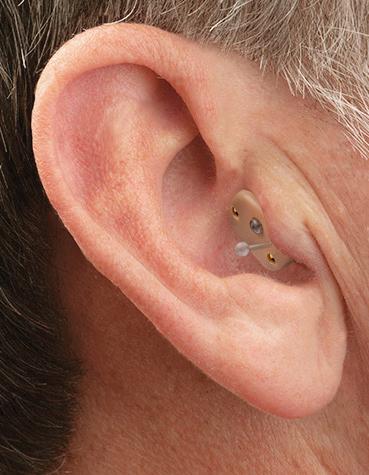
















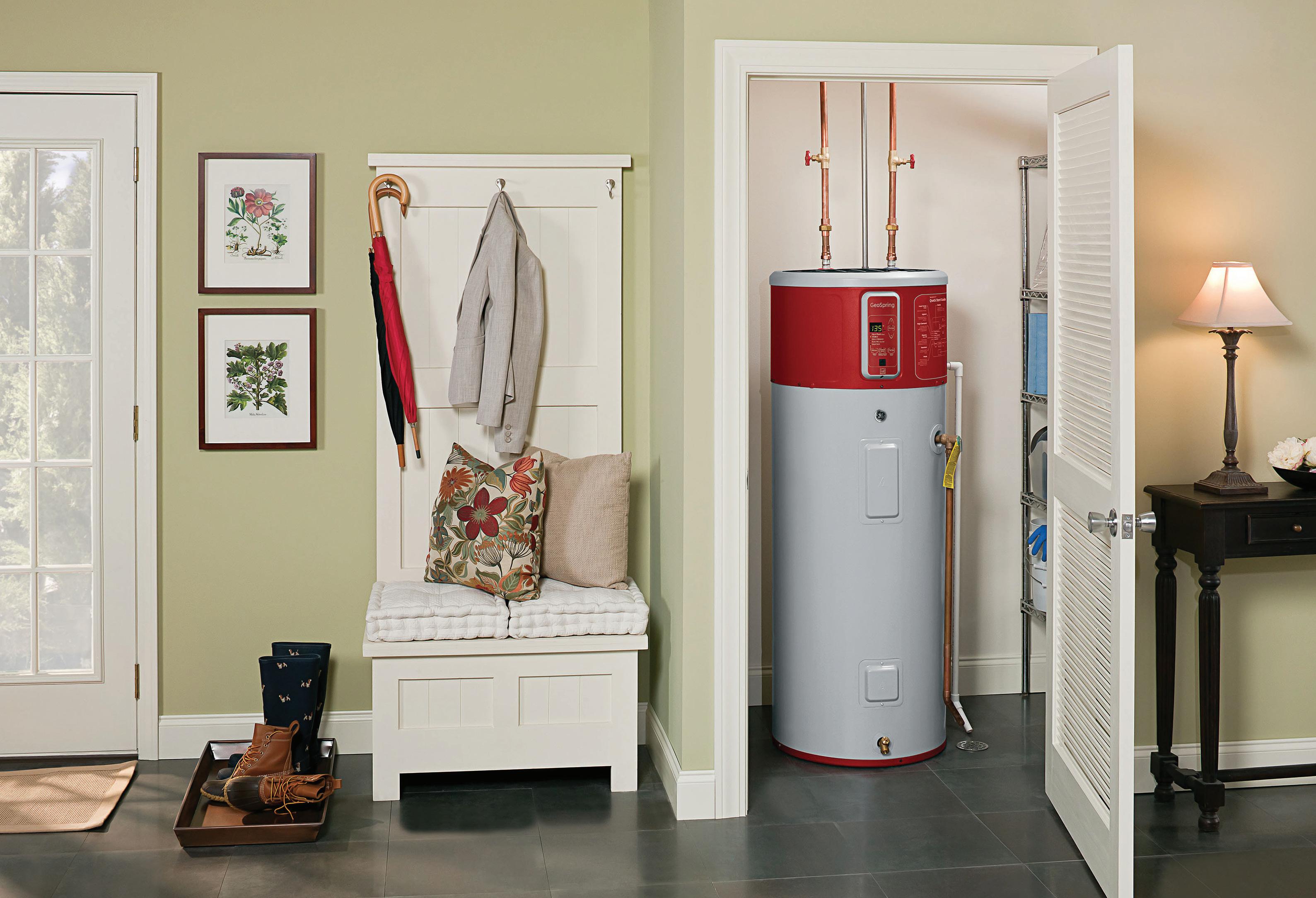
By Victoria Hampton
Advancements in technology have increased efficiency and lowered energy use for many home appliances. While smart thermostats and refrigerators are common home upgrades that help people save on electricity bills, one of the most efficient upgrades homeowners can make is to an appliance many haven’t touched in months—the water heater.
A standard electric water heater accounts for nearly 20% of the energy use in a home, which is more than a refrigerator, clothes washer and dryer combined, says Bonneville Power Administration Program Manager David Murphy.
Learn about the technology and potential energy savings for switching to an energy-efficient heat pump water heater.
Heat pump water heaters can save up to $450 a year, or $4,500 over the system’s lifetime, David says. Savings are dependent on each home’s utility rates and hot water use. Systems come with a 10-year warranty.
David says heat pump water heaters can provide more hot water than similarly sized standard systems. Many tanks also have leak detection that can warn homeowners if an issue arises.
Systems have several automated settings, including maximum hot water generation when guests stay the night, high-efficiency eco mode and advanced vacation mode settings, allowing homeowners to program their return—so they come home to hot water.
“Automation, like many things we see in the technology realm, increases control of your settings,” David says. “[You]
get the benefits you need while still using less energy.”
Although the upfront cost of a heat pump water heater is typically more than a standard system, homeowners can save with rebates and incentives. Electric utilities can provide information on available savings for heat pump water heater upgrades.
“Always talk to your local utility to see what they have available,” David says.
Heat Pump Efficiency
Think of a heat pump water heater as a refrigerator in reverse. A refrigerator pulls heat from inside the box and sends it outside the appliance. A heat pump water heater pulls heat from the surrounding air.
“It is a unit driven by a compressor that harvests heat from the air and puts it into your water tank,” David says.
What is the importance of this state-of-the-art heat pump technology? It uses about one-third of the energy of a standard electric water heater. This increased efficiency can lead to lower electric bills.
Heat pump water heaters are ideal for garage and basement placement. When installing in a closet, consider the compressor noise and cold air released when it is running. The compressor can also be vented outside.
Pulling heat from the air creates moisture. Each system has a condensate line pipe—a plastic tube using gravity to draw out excess condensation from the unit. This feature does require a small amount of space near the heat pump water heater for the condensate removal pump or drain piping to the outside of the house.
Also, as with any water heater, homeowners should choose a tank size that matches the number of people in the home. Tanks vary in price.
Heat pump water heaters add a few more simple tasks to your quarterly home maintenance check. When changing the HVAC air filter every three months, clean the heat pump water heater filter as well. Use a vacuum or rinse it with water to remove any debris.
Check the condensate line pipe for clogs and dirt when cleaning the filter. The line can be cleaned with a brush or rag.
When it is time to upgrade the household water heater, make the switch to an efficient, energy-saving heat pump water heater.
Watch a video about how to use and maintain a heat pump water heater at comfortreadyhome.com/guides/ hpwh-user-guide
By Leslie Tate
A ductless air conditioner, also called a mini-split system or air-source heat pump, offers a variety of options for heating and cooling, particularly for older homes and buildings.
A mini-split system can provide several benefits, but the most attractive feature is the capability to regulate temperatures in specific rooms or areas of the home.
An indoor air-handling unit, or evaporator, and an outdoor compressor/condenser comprise the two major components of a mini-split system. In many ways, mini-split air conditioners operate like conventional air-conditioning systems. In cooling mode, the system transfers heat from inside the home to the outside. With a central air system, cold air is blasted throughout all the ducts in the house from a single air handler, such as a large fan in an attic or basement. Because a mini-split can blow air from up to six independent air handlers, it can regulate temperatures for different rooms or areas inside a home or business.
Mini-splits are a viable alternative to duct systems for home additions or homes where a duct system may not be practical. When a duct system is too expensive to install, a mini-split system can efficiently heat and cool a space while keeping installation costs down.
Compared to conventional heating, ventilation and air-conditioning systems, minisplits can save up to 30% on cooling costs and 50% on heating costs. Additionally, inverter technology, which enables variable-speed operation in most mini-split systems, increases energy efficiency and is cheaper to operate.
In addition to greater control over heating and cooling, mini-splits can often be managed with a mobile app, smart thermostat or remote control. They provide better air quality, and homeowners can easily replace filters themselves and save on duct cleanings needed for conventional systems. Reheat dehumidification is a common feature of minisplit systems to maintain a steady room temperature while lowering humidity.
A few factors should be considered before installing a mini-split system. Determine the right size and quantity of units. Mini-split placement should consider how to best distribute air throughout the home or business. A qualified contractor can offer advice on these factors. Additionally, your home should be properly air sealed for the minisplit system to operate efficiently.
For many homeowners, a mini-split ductless heating and cooling system can be a fantastic alternative for heating and cooling. Contact your local electric utility if you have questions about mini-split systems.

All ages can find something new and exciting around every corner of the state. Filled with rich history, abundant natural beauty and diverse events all year, Florida has something fun for everyone.
July 1-3
Space and Rockets Summer Camp
Travel to the galaxy at Space and Rockets Summer Camp. Campers learn about our place in the universe as they design and launch their own waterpowered rocket. Experience is not required, but the laws of motion are. Register online.

https://www.edisonfordwinterestates.org/education/camps; 239-334-7419
July 3
Freedom Rocks! Fireworks
Come early and dine at any Freedom Rocks participating waterfront restaurants rock a spot with the glorious sunset washed colors painting the skies above the Grand Lagoon Bridge or bring your chair/blanket to the grassy lawn at Treasure Island Marina. Come early and shop, dine and have fun.
www.panamacitybeach.com; 850-233-5070
July 3-7
The Key Lime Festival
Key West’s annual Key Lime Festival celebrates the world’s most sensational citrus with an array of festivities across the island where Key lime pie was conceived. Over five days, lovers of the lime can indulge in a full menu of activities including a gravity-defying Key lime pie drop competition from the top of the Key West Lighthouse, brunches and dinners, and the world famous Key lime pie eating championship.
www.keylimefestival.com

July 6
Salt Air Farmers Market
Treat your family to art pieces and fresh veggies, sweet tupelo honey and vine-ripened fruit from local farmers and artisans. This market is open 9 a.m. to 1 p.m. the first and third Saturdays.
http://saltairmarket.com; 404-906-2637

July 6
Flora-Bama Freedom Run
This annual run features two courses: The 4-Mile Run/Walk Course or the 1-Mile Fun Run/Walk. From ribbons and bows to flags, socks & T-shirts, break out your best red, white and blue attire.
https://florabama.com/freedom-run; 850-492-0611



July 6
History Tour at Camp Helen
Join park ranger staff for a guided history tour of the grounds at Camp Helen. Follow along as staff share park history from the Hicks family building the historic structures that still stand on the grounds, all the way through the colorful history of Avondale Textile Mill’s use of the property for its employee summer retreat. Dress appropriately for the weather, and bring water and insect repellent.
https://floridastateparks.org/events/history-tour-camp-helen-3; 850-245-2157


July 11
All About Sea Turtles
Why do sea turtles cry salt? How long do they really live? Where do they lay their eggs? Get the answers to these questions and any others you may have during this indoor presentation all about sea turtles. Florida Coastal Conservancy Director Jessica Swindall will lead the presentation and pass around interesting items such as shells, skulls and more. https://floridastateparks.org/events/all-about-sea-turtles-7; 850-245-2157
July 12
Blue Beachside Bazaar
The Pensacola Beach Chamber is delighted to offer attendees of the Red, White & Blues Pensacola Beach Airshow the opportunity to visit the Blue Beachside Bazaar. Ten vendors will be set up at show center. www.visitpensacolabeach.com; 850-932-1500
July 14-16
12th Annual VFW Fishing Tournament
Cash prizes will be awarded for the heaviest catch of five target species—mahi-mahi (dolphinfish), wahoo, tuna, snapper and grouper, with a first-place prize of $5,000 for the heaviest mahi-mahi. Anglers fish in seven divisions: pee-wee, junior, lady, first responder, veteran, senior and active duty. Captains and anglers can choose to fish either Saturday or Sunday, or both if they register separately for each day. All proceeds benefit veterans with disabilities of Monroe County.
https://vfw3911.org/di/vfw/v2/default.asp?pid=143668; 305-294-9968


July 16
Library Concert
Join us for an afternoon of music at the Pensacola library. Local singers present favorite arias and musical theater tunes for a free concert for the whole family. Performing artists include soprano Sheila Dunn, soprano Bizhou Chang, baritone Jack Chandler and pianist Cody Martin. www.pensacolaopera.com/event/library-concert; 850-433-6737
July 17-21
Hemingway Days
Ernest Hemingway look-alikes, writers, anglers and fans gather for the annual Hemingway Days celebration. The festival honors the legacy of the American literary giant who lived and wrote on the island for most of the 1930s. Events include the legendary Hemingway Look-Alike Contest, the wacky Running of the Bulls, presentations, prose and poetry readings, a commemoration of the 125th anniversary of Hemingway’s July 21 birth, a museum exhibit, a 5K run and paddleboard race, and a street fair. https://fla-keys.com/hemingway-days; 800-352-5397
July 20



The Owls of Florida
Although they are birds of prey, owls are not related to other raptors such as hawks, and the evolution of the owl group is something of a mystery. Learn all about our local owls, including how they hunt, what they eat, their unique sensory organs and their peculiar behaviors. You’ll want to glove up toward the end of this session when we explore owl “pellets.” www.visitgulf.com

Want to share a family-friendly event with the readers of Florida Currents? Head online and enter the details at tinyurl.com/FloridaCurrents. Make sure to submit the item at least 60 days before the event (due to press deadline). If you own rights to a print-quality photo promoting your event, include it with photo credit information.

Even during the oppressive heat of summer, your Florida landscape can be home to a variety of bedding plants.
Before you jump into planting, think about the specific growing conditions in your landscape. For example, consider how much sun or shade your yard receives and how well-drained the site might be. Those with coastal landscapes should look for plants that can tolerate high winds and at least some level of salt—be it from sea spray or irrigation from wells that contain high levels of salt.
After you’ve considered your site’s conditions, think about colors and forms of the plants. Limit the varieties and colors you choose to create a cohesive look and prevent visual confusion.
Annuals are plants that last one season, and there are lots of warm-season annuals that can bring color into your garden as the temperature rises. Gardeners love using annuals in the landscape because they allow them to change out plants and try new configurations year after year.
If you like plants with cool-colored blooms, try torenia—also known as the wishbone flower. This plant does well in the shade or the sun. Flowers can be white, yellow, pink, violet or purple, depending on the cultivar.
For eye-catching color, try the cora and nirvana series vincas. They have big flowers and are resistant to heat, drought and pests.
Zinnias have long-lasting flowers ideal for a cutting garden. This heat-loving flower comes in many colors.
If you’re looking for standout foliage, coleus and caladiums add nonstop summer color to your sun or shade garden.
Perennials
When other plants are fading in the heat, perennials such as Pentas lanceolata truly shine. These attractive plants produce red, pink or white flowers throughout the summer, and are a great source of food for hummingbirds and butterflies.
Scarlet salvia is a native of the Southeast. Its red flowers attract butterflies and hummingbirds. This Florida-friendly perennial looks especially attractive as a border or in mass plantings.
Lantana exhibits outstanding heat tolerance and can stand up to wind and salt as well, making it a good choice for people who live near the coast. Nectar-laden blossoms make it a natural choice for butterfly gardens. That said, many species are highly invasive, so choose lantanas safe for your landscape.

Melampodium is a tough, drought-tolerant plant that produces a mound of small yellow flowers throughout the summer. Several varieties are available, such as the compact million gold, lemon delight and derby. These varieties top out at about 10 inches.
Showstar and medallion are taller varieties that reach 24 to 36 inches tall. Melampodium is impressively resistant to disease and insects. It is self-cleaning, so deadheading—removing old blooms— is not needed.
Make sure you select healthy plants to start. Look for unblemished leaves, good green color and lots of flower buds.
Once you select the right plants for your area, make sure you start out with a properly prepared planting bed. For best results, clear a section of your landscape for the bed by removing grass and weeds. A few weeks before you plant, till at least 6 inches down and add organic matter—such as compost—to enrich the soil.
Fertilize your flower beds before you plant or at planting time with a controlled-release complete fertilizer.
Before taking the plants out of the containers, water the pots, then gently loosen and spread the roots out. Once they are in the ground, add mulch to help retain moisture and keep weeds down.
A border around your planting bed helps keep your grass from invading the area.
Many annuals, such as marigolds, coleus and annual salvia, require deadheading to keep them blooming and looking neat.
Others, such as vinca, wax begonias, portulaca and impatiens, continue to flower without removing spent blooms. Tender annuals are damaged by cold weather, so you can leave them in your landscape until the first frost or freeze, or you can pull them out and replace them with hardier cool-season annuals to give your landscape some winter color. n

Natasha Atlas graduated from the University of Florida’s Agricultural Education and Communication Program in 2021. She loves writing about unique and new varieties of flowers and plants for the Neighborhood Gardener Newsletter and its 10,000 subscribers. When she isn’t writing, she enjoys tending her own garden on her balcony.
For Rent
Horse barn with five stalls, paddock and about 4 acres of pasture in Wewahitchka, one block from the old courthouse. Lease by the stall, with discount for multiple horses. 740-334-0341.
12 acres coastal Bermuda pasture. Irrigation available. 850-814-7015 or 850-814-6078.
For Sale
Miniature donkeys. Jacks and jennies; black, brown, gray and paints. All ages. $300 and up. Make great pets. Also, standard donkeys. Betty, 850-899-7424.
30 ft. rabbit pens, including feeders and self-watering systems. Located 22 miles south of Chipley. $450. Alan, 229-421-0790.
Towing straps, $6 each. Text only, 850-257-3056.
Real Estate
FSBO: Two adjacent lots, about 2.5 acres on paved road, 10 miles north of Wewahitchka, 45 minutes from beaches. Border the Chipola River and Cypress Creek. Cleared and ready to build. Quiet and peaceful; no neighbors. Deeded restrictions. Underground utilities, deep well, many fruit trees. $69,900. 850-648-4214.
Three-bedroom, two-bath home on 1-acre lot on the Choctawhatchee River at Cedar Log Boat Ramp, 80 Old Creek Road, Ponce de Leon, FL 32455. Wayne, 850-373-7944; or Jason, 850-258-1085.
2.5 acres lakefront on Deerpoint Lake, 30 to 45 minutes from Panama City. Paved road, electricity, septic, close to schools, quiet and peaceful. Can be divided. Asking $299,900. 850-265-5554.
Two residential lots on Maulden Road in Calhoun County. Above flood area near Chipola River in the Scotts Ferry area. 850-814-6078.
Half-acre corner lot. 850-639-2220.
Miscellaneous
Merchant Management Group is a local payments technology company based in Panama City, working with quickservice restaurants, full-service restaurants and retail shops and specializing in the latest point-of-sale systems, including Tabit, OrderCounter and Clover. Have worked with hundreds of Gulf Coast businesses since 2004 and have an A+ rating with the BBB. Schedule your demo, 850-747-0664.
Kapua Kleans for your final interior cleanup, deep clean, residences, condos, rental properties. Steph, 850-704-2412.
Carter’s Land Clearing and Mulching LLC. 850-527-4715.
Rachel’s Facials, Lashes and Brows at 2518C Highway 77 in Lynn Haven. Now offering full body waxing and esthetician services, including back facials, extractions, chemical peels, eyelash extensions, brow and lash tinting, and makeup artist services. Rachelsflb.com or call 850-896-4855.
Koastal Home Repair LLC. Fencing, decks, painting, light tractor work, repair work and maintenance. Insured. 850-227-5509.
C&2 Electrical Services LLC. Residential and commercial electrician services. 850-899-8218 or 850-899-8217.
Tree Be Gone. For all your tree needs, from trimming to complete removal. 850-819-9987.
WJ Land Management. Florida licensed and insured. Forestry mulching, land clearing, culverts, fencing. Fast, free and reliable estimates. William, 850-628-4714; or Tabatha, 850-628-4713.
Hamco Business Solutions is conveniently located in downtown Panama City with its warehouse in Lynn Haven. Hundreds of products at discounted prices, including receipt paper, ink cartridges, deli paper, kitchen paper and copy paper. Free, same-day delivery on most products. Shop local and save. Call for a free quote, 850-942-5600.
SLR Farm & Landscaping. Lawn care, grass cutting, bush hogging, backhoe work. 706-575-4570 or 850-703-5321.
Handyman services. Painting, flooring, building repair, odds and ends. Free estimates and fully insured. TJ, 207-612-8255 or 207-578-1830.
Custom fences built on your property. Call David for your free estimate. 850-819-9987.
The 850 Stump Grinder LLC. Free estimates, multistump discount, residential and commercial. Veteran-owned and -operated. 850-814-0720.
Wanted
Someone to do yard work and odd jobs in the Dalkeith area. $20/hour. 850-639-2156.
Trading Post is a FREE service to Gulf Coast Electric Cooperative members. GCEC reserves the right to edit or reject ads. PLEASE PRINT LEGIBLY OR TYPE.
Please circle the category that applies: For Rent For Sale Real Estate Free Miscellaneous Trade Wanted Items:
Name: Phone:
Address:
Mail your ad to: The Trading Post; Gulf Coast Electric Cooperative; 9434 Highway 77; Southport, FL 32409; return with your electric payment; or email ad information to tradingpost@gcec.com.
** Due to press deadlines, please expect up to 60 days from submission for your advertisement to appear.




Gulf Coast Electric Cooperative sponsored the Eastern Shipbuilding Group’s 22nd annual Freshwater Classic on May 19 on the Apalachicola River. This year’s tournament had 550 registered participants and raised $30,000 to benefit Gulf Coast Children’s Advocacy Center.
Gulf Coast Electric Cooperative entered the team of Matthew Fleming, Issac Madrid and Tyler Whitten in the tournament. Tyler won the trash fish division with a 16.51-pound catch.


For more information and photos from the event, visit www.facebook.com/ EasternShipbuilding.


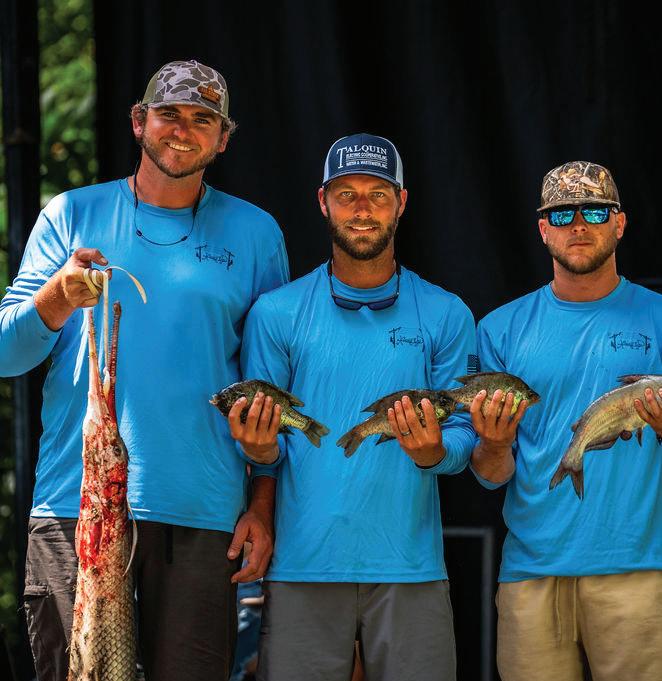




Among the oldest, simplest and still most effective techniques for catching many saltwater species, a popping-cork rig can put redfish, speckled trout, sheepshead, flounder and other fish in the boat quickly.
In brackish areas, anglers might also catch largemouth bass.
A popping-cork rig essentially consists of a float holding up an enticement. Some corks somewhat resemble an old topwater popper. When jerked, the concave shape gurgles the water, simulating a fish striking prey on the surface.
Other corks take a more traditional round or oblong shape but slide up and down a wire stem to create the same type of commotion.
Attach a float directly to the line—18 to 36 inches above a hook, depending upon the depth. For added casting heft, attach a small, split-shot sinker to the line between the hook and the cork.
Some companies sell pre-rigged packages that come equipped with a cork, leader, weight, rattles, and plastic or metal beads that create additional noise and vibration.
Cast to a likely spot and let it sit for a
few moments. Periodically, jerk the rod to make the cork pop the surface. When the cork goes down, set the hook.
With popping corks, most anglers use live shrimp for bait. Hook a shrimp under the horn. Carefully avoid hitting the black spot in its head, which could kill it. Alternatively, try hooking the shrimp through the meaty part just above its tail.
Other live or cut baits also work, depending upon what anglers want to catch. Some people use live minnows, small mullets, croakers, menhaden and fish chunks. For redfish and black drum, use small whole blue crabs or crab pieces.
Various artificial temptations can also work, such as soft-plastic shrimp or minnow imitations or flies.
With artificial baits, pop the cork more frequently. When spooked, a live shrimp naturally flicks its tail to escape and rises to the surface. When an angler pops a cork dangling a plastic shrimp, the lure flies upward and then sinks again, exactly like a live shrimp.
Fish hear the commotion and think one of their cousins took a shot at a shrimp and missed. Then, they see the morsel
sinking and dash in to grab it before another fish eats it.
Popping corks generally work best in shallow water. Set the depth so the bait hangs just above the bottom. Cast so the corks drift along weedy shorelines or over oyster reefs and other structures. Let the wind or tide carry the cork along naturally.
Many fish gather on the downstream side of points. They look into the flow waiting to ambush anything rounding the point. Toss the rig so the prevailing wind or tidal flow carries the cork across the point.
During a falling tide, fish often congregate at the mouths of tiny drains. Throw the cork as far as possible upstream in any marshy drain. Let the current carry the temptation downstream naturally. Pop the cork occasionally. In the right spot, action can come fast. n

John N. Felsher is a freelance writer, broadcaster, photographer and editor. He’s written more than 3,500 articles on a wide variety of outdoor topics. Contact him at j.felsher@hotmail.com or through Facebook.

A state tax relief plan continues to offer savings for Florida shoppers.
The tax relief package includes a permanent exemption for baby and toddler necessities, such as strollers, cribs, diapers and baby wipes. The tax relief package includes a back-to-school sales tax holiday lasting 14 days each, two disaster preparedness sales tax holidays lasting 14 days each, and a freedom month sales tax holiday on recreational items and children’s toys that lasts until the end of July.
Back-to-school savings. This sales tax holiday runs July 29-August 11. During the sales tax holiday, tax is not due on the retail sale of:
• Clothing, footwear and certain accessories with a sales price of $100 or less per item.
• Certain school supplies with a sales price of $50 or less per item.
• Learning aids and jigsaw puzzles with a sales price of $30 or less.
• Personal computers and certain computer-related accessories with a sales price of $1,500 or less, when purchased for noncommercial home or personal use.

The sales tax holiday does NOT apply to:
• Any item of clothing with a sales price of more than $100.
• Any school supply item with a sales price of more than $50.
• Books that are not otherwise exempt.
• Computers and computer-related accessories with a sales price of more than $1,500.
• Computers and computer-related accessories bought for commercial purposes.
• Rentals of any eligible items.
• Repairs or alterations of any eligible items.
• Sales of eligible items within a theme park, entertainment complex, public lodging establishment or airport.
Diapers and clothing Tax is not due on the retail sale of children’s
diapers or baby and toddler clothing and shoes primarily intended for children ages 5 or younger. Items such as accessories and receiving blankets are also included.
Disaster preparedness. This sales tax holiday runs August 24September 6. During this sales tax holiday, tax is not due on the retail sale of eligible items related to disaster preparedness.
Eligible items include:
Sales price of $10 or less per can or pouch (or the equivalent if sold in a box or case) of wet pet food.
Sales price of $15 or less per item or package:
• Cat litter pans.
• Collapsible or travel-sized food or water bowls.
• Hamster or rabbit substrate.
• Manual can openers.
• Pet waste disposal bags.
Sales price of $20 or less:
• Reusable ice packs.
• Collars.
• Muzzles.
• Leashes.
• Pet pads.

Sales price of $25 or less per item of cat litter weighing 25 pounds or less.
Sales price of $30 or less:
• Laundry detergent and supplies, including powder, liquid or pod detergents; fabric softener; dryer sheets; stain removers; and bleach.
• Other household supplies, including toilet paper; paper towels; paper napkins and tissues; facial tissues; hand soap, bar soap, and body wash; sunscreen and sunblock; dish soap and detergents, including powder, liquid and pod detergents or rinse agents that can be used in dishwashers; cleaning or disinfecting wipes and sprays; hand sanitizer; and trash bags.
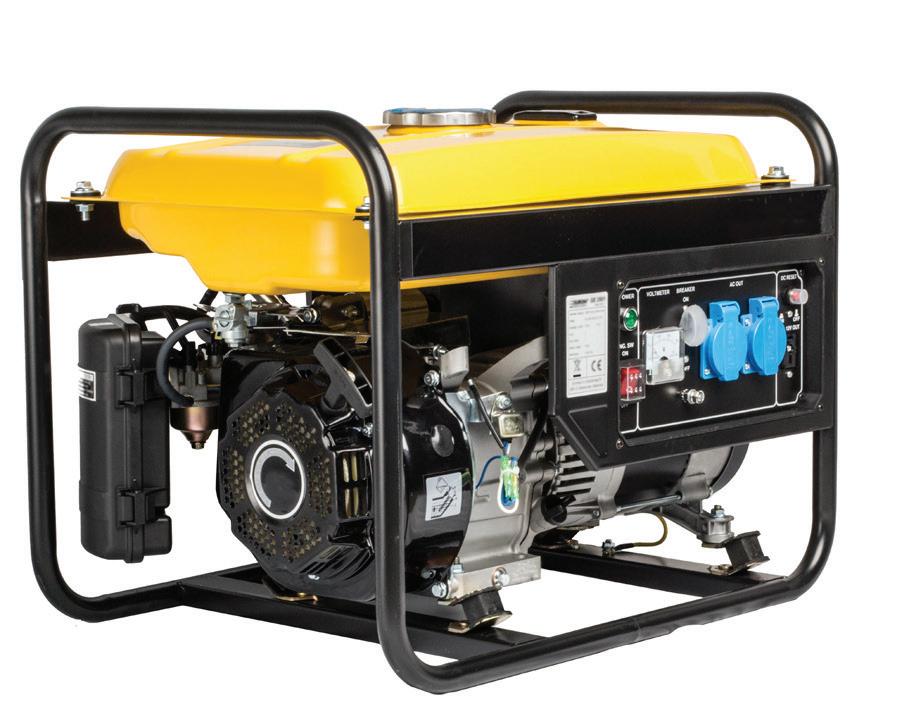
Sales price of $40 or less:
• Any portable, self-powered light source (powered by battery, solar, hand-crank or gas) such as candles, flashlights or lanterns.
• Pet beds.
Sales price of $50 or less:
• Any gas or diesel fuel container, including LP gas and kerosene containers.
• Batteries, including rechargeable batteries, listed sizes only (excluding automobile and boat batteries): AAA-cell, AA-cell, C-cell, D-cell, 6-volt and 9-volt.
• Portable radios (powered by battery, solar or handcrank): two-way or weather band.
Sales price of $60 or less:
• Coolers and ice chests (food storage; nonelectrical).
• Portable power banks.
Sales price of $70 or less:
• Carbon monoxide detectors.
• Fire extinguishers.
• Smoke detectors or smoke alarms.
Sales price of $100 or less:
• Bungee cords, ratchet straps and tarps.
• Ground anchor systems.
• Tie-down kits.
• Visqueen, plastic sheeting, plastic drop cloths, and other flexible and waterproof sheeting.
• Bags of dry cat or dog food weighing 50 pounds or less.
• Pet carriers and portable kennels.
• Over-the-counter pet medications.
Sales price of $3,000 or less:

• Portable generators used to provide light or communications, or to preserve food in the event of a power outage.
Freedom month. This sales tax holiday lasts July 1-31. During this sales tax holiday period, tax is not due on the retail sale of admissions to music events, sporting events, cultural events, specified performances, movies, museums, state parks and fitness facilities.
Also exempt from sales tax during this holiday period are eligible boating and water activity supplies, camping supplies, fishing supplies, general outdoor supplies, residential pool supplies, children’s athletic equipment and children’s toys.
Tool Time. Consumers can purchase qualifying tools and equipment exempt from tax September 1-7.
Eligible items include:
Sales price of $25 or less:
• Work gloves.
Sales price of $50 or less:
• Hand tools.
• Safety glasses ($50 or less per pair or the equivalent if sold in sets of more than one pair).
• Protective coveralls.
• Duffle bags or tote bags.
• LED flashlights.
• Shovels.
• Rakes.
• Fuel cans.
Sales price of $75 or less:
• Toolboxes.
• Hearing protection items.
Sales price of $100 or less:
• Tool belts.

• Electrical voltage and testing equipment.
• Shop lights.
• Hard hats and other head protection.
Sales price of $125 or less:
• Industry textbooks and code books.
Sales price of $150 or less:
• Power tool batteries.
• Handheld pipe cutters.
• Drain opening tools.
• Plumbing inspection equipment.
Sales price of $175 or less:
• Work boots.
Sales price of $300 or less:
• Power tools.
• Toolboxes for vehicles.

For more information, visit floridarevenue.com/salestaxholidays. n
Florida’s geography is vast and beautiful, from lakes to oceans and parks to beaches. Some of you have views from your homes that rival the views of national parks.
From time to time, we share some of readers’ photos in this space. If we use your photo here, we will send your choice of a $25 gift card to REI or Amazon.
To submit your photo, email a JPEG file to photos@floridacurrents.com. Include “Before You Go” in the subject line. Please share a bit about what inspired you to make your photo.
A lizard rests on a leaf in Sonya Casasnovas’ garden in Parrish. At one point, the lizard stopped to look her in the eye. By the expression, Sonya believes it was a bit annoyed. PHOTO BY
SONYA CASASNOVAS


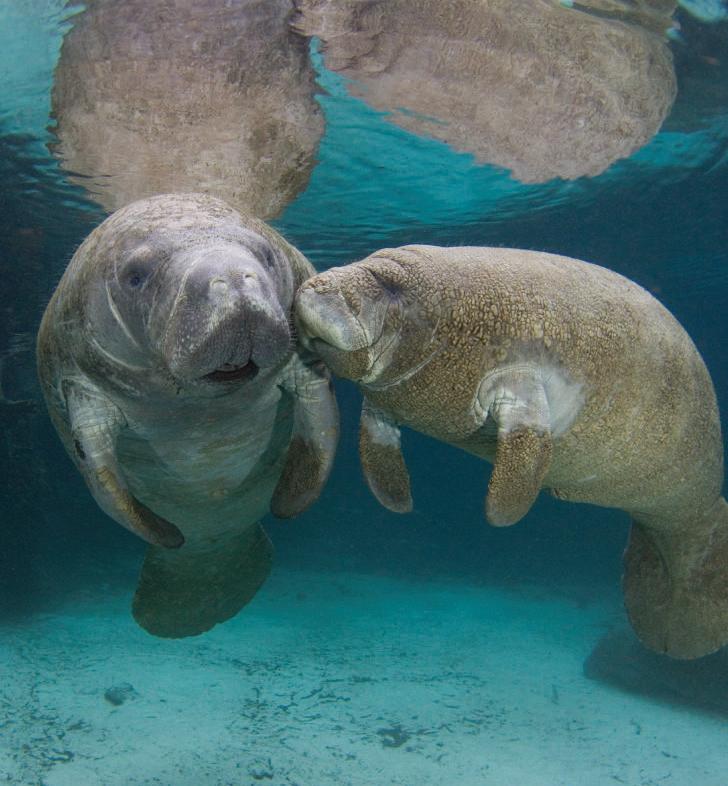
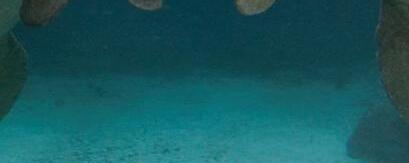



Save the planet without leaving the house.
Going solar at home helps reduce pollution and carbon emissions in your city and around the world. And it’s easier and more affordable to do than ever before—that’s why every four minutes another American household or business goes solar. Find out how you can be next. RENEWABLE IT’S DOABLE
722 W. Highway 22
P.O. Box 220
Wewahitchka, FL 32465
850-639-2216 or 800-333-9392
9434 Highway 77 Southport, FL 32409
850-265-3631
Outages: 800-568-3667
6243 E. Highway 98 Panama City, FL 32404 850-481-1188
www.gcec.com
ceO/General ManaGer
John Bartley
TrusTees
President Dwight Van Lierop
Vice President Betty Moore
Secretary/Treasurer Jimmy Black
Doug Birmingham
Rupert Brown
Robert Byrd
Kinneth Daniels
Carl Goodson
Eddie Jones
Trustees normally meet the third Tuesday each month at 12:30 p.m. CST.
The mission of GCEC: Fulfilling the changing needs of our membership and communities by providing costeffective, reliable and safe utility services through a dedicated and responsive workforce.
Gulf Coast Electric Cooperative offices are closed Thursday, July 4, in observance of Independence Day. You may report power outages and access your account 24 hours a day, seven days a week via our app, website or automated phone system. From all of us at Gulf Coast Electric, have a safe and happy holiday.
One of my favorite things about summer is the opportunity for fresh, homegrown food, whether shopping at the local farmers market or sharing the abundance of garden tomatoes with a neighbor. It’s amazing how just a few seeds, some fertilizer and water can become a bounty.
When I think about energy efficiency, I think about that bounty of food and how you can use less electricity with just a few simple actions and reap the rewards of energy savings.
You don’t need to be a farmer or botanist to know plants need water—just like you don’t have to be a lineworker or engineer to know adjusting the thermostat or turning off lights can reduce your monthly electric bill. If you read Gulf Coast Electric Cooperative’s publications regularly and follow us on Facebook, you know there are many things you can do at home to save electricity and money.

Summer months bring some of the highest energy bills of the year. But why? Cooling your home accounts for a large portion of your monthly energy use, and the hotter it gets, the harder (and longer) your air conditioner must work to keep you cool.
There are several ways we can help you manage energy use at home—not only during the dog days of summer but throughout the year. One of the great things about being part of GCEC is we’re locally owned by you, our members. So, instead of making profits, we can focus on helping our community. That’s why we’ve developed incentives and programs to help you keep your money in your wallet.
Save money with these easy incentives:
• Rebates. GCEC offers ways to give you money back for efficient equipment you buy, like heat pumps and water heaters.
• Recycling. If you have an old refrigerator or freezer running but not used much, it’s costing you. Consider recycling it.
• Free energy audits. Our energy adviser can determine the overall efficiency of your home and help you find ways to improve it.
• Taking control of your use. Use our app or website to track your energy use.
• Varied ways to pay. If you’re having difficulty paying the higher bills that come with increased use in the summer, contact us to learn about our levelized billing or FlexPay.
Most people don’t know everything about electricity, and that’s why we’re here to help you. There are no investors making profits here. Just knowledgeable people with local jobs, working for our neighbors to ensure electricity is available when you need it. Contact us, and we can work with you to find more ways to save energy—and money.